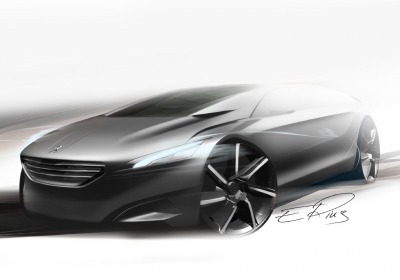First Sight: Peugeot HX1 concept
Mon, 29 Aug 2011This is Peugeot HX1 concept car, which will be launched at this year's Frankfurt motor show. With a longer wheelbase than the BMW 5 Series, but lower, wider and 50mm longer, it measures in at 4950mm long, 1950mm wide but stands only 1400mm tall. But it looks immense. The narrow DLO adds to the illusion, and the low glasshouse adds length while the unbroken body surface leaves a clean and sober, upper class – nearly arrogant – impression.
In many ways the HX1 concept is unlike anything Peugeot has ever created. With minimal overhangs, especially in the front, and a very sober grille – first introduced on the Gilles Vidal-directed SR1 concept – the only feline traits (for many years the Peugeot-defining DNA), come in the form of the front lights, partly extending from behind small flaps when in use. You will look in vain for deeply-rooted Peugeot tradition here.
The reason for that is easy to explain. The only real Peugeot veteran in the team behind this project is Sylvain Henry, who contributed on the exterior design for this concept. He worked with Gerard Welter when work started on the 407 in the late 90s. The rest of the team hasn't been here that long and head of the group, Per Selvaag – now Responsable Style Avance de Phase & Concept Car – arrived last November. His last employer was BMW, and before that he was exterior designer on some of the Gerry McGovern Lincoln concepts, having graduated from Coventry University in 1995.
You would suppose he knows something about 'premium' with that background, and his brief to the designers, when Vidal hired him last autumn, was simply: French Luxury ("with emphasis on 'French'")
"As you may have noticed, our products are heading north in terms of refinement and we feel that one of the keys to our future successes lies in our ability to explore uniquely French qualities in our products," explains Selvaag. "We are interested in differentiating ourselves from our car-making neighbors to the not-so-far east."
Selvaag attests that "German cars do not have to be the benchmark for 'premiumness' [a Gerry McGovern-ism], but as long as the rest of the world tries to emulate them, they will continue to be just that. So this was a fun challenge. And to us, the play of materials, graphics and proportions, inside and out, is what makes this a unique proposition.
"The exterior is a provocative way of looking at space utilization. Six seats poses a proportion challenge and a period of denial, when an exterior design team has to try and make a people-mover look attractive. With the HX1, we suggest that good wheel-to-body, sumptuous sections and strong, simple graphics can surprise and delight, even with zero dash-to-axle. We also feel that the concept falls under an expanding umbrella of unique-to-PSA products that are hard to categorize; like the Peugeot 3008 and Citroën DS5. These are products that are interesting for their unique architecture."
In the exterior team we find Emmanuel Rius who provided the main themes initially and worked with Henry during the labor-intensive development of finessing and adjusting the volumes. When asked about how many designers contributed initial sketches for the project, Selvaag answers: "Probably a nice, round number – like 20. People have various workloads and although the total number of designers in all studios is much higher, the period leading up to the competition last year was very busy. So either you created design proposals while eating dinner at home after work, or you happened to have a little bit of time to spare for the project."
The engineering talent that has somehow not only made all Peugeot concepts the last ten years into real, live motorcars, but also ensures that all the small details function is, as usual, that of Fabrice Santangelo. Here he has engineered a complete, hybrid car on something that is definitely not a normal PSA production platform. But he has also added subtle details like the front seats, wheels that transition into spokeless, flat discs when speed builds up, and impressive rear spoilers – not only above the rear hatch, but also at the corners. Obvious, when you realize that guiding the flow around corners is as important as assisting the flow over kinks.
Continues →
By Jon Winding-Sorensen



